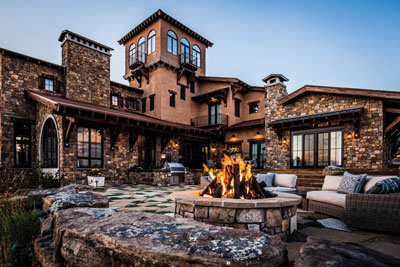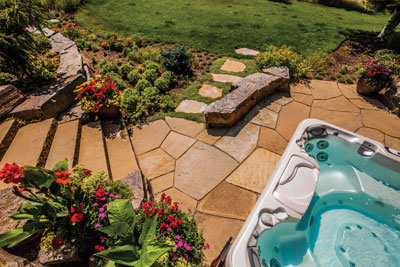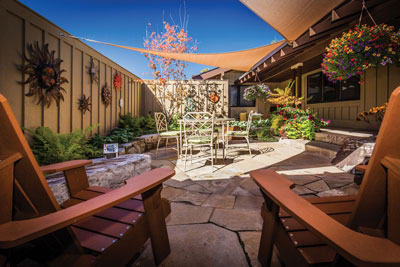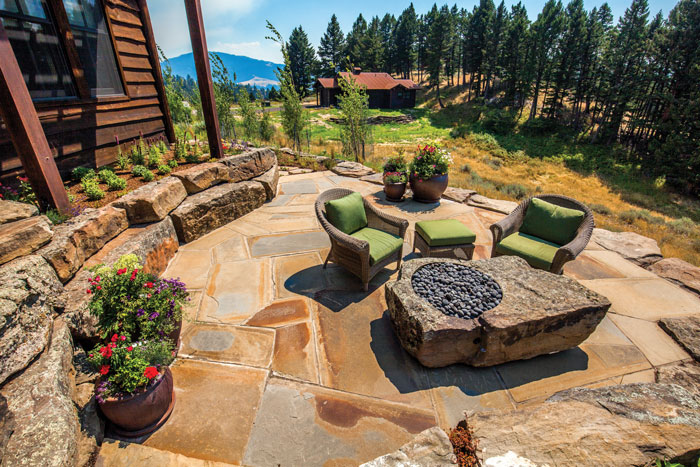Smaller lawns are big news, and living large outdoors is in. Homeowners want more native plants, but they also want their yard looking good year-round. And they want to use new technology to better manage their outdoor water use.
These are just a few of the trends that irrigation and green industry experts identified when we asked them what’s hot and what’s not in landscape design, as well as how these latest developments affect irrigation work.
Here are four trends they identified as becoming more popular in the past year, as well as tips for how landscape and irrigation contractors can work with them.
Living large outdoors
Probably the biggest trend contractors mentioned was outdoor living spaces. People want to connect with nature while still enjoying the amenities of the indoors and with less yard to care for. This means more hardscapes (especially higher-end ones such as stained or polished concrete); more outdoor furniture; more outdoor lighting, kitchens and fireplaces; and of course, more technology such as outdoor TVs.
 For landscape designers and contractors, this may require increased coordination with irrigation subcontractors as they seek to ensure these progressively more nuanced outdoor living spaces stay beautiful year-round.
For landscape designers and contractors, this may require increased coordination with irrigation subcontractors as they seek to ensure these progressively more nuanced outdoor living spaces stay beautiful year-round.
Andy Blanchford with Blanchford Landscape Group, a residential design-build company that focuses on the Big Sky ski resort market near Bozeman, Montana, says that he’s seen a big shift in recent years. Whereas he used to install a lot of softscapes, that portion of his business has precipitously fallen off while installation of “really fantastic outdoor living spaces” has risen dramatically.
These outdoor spaces have become an increasingly important way for people to decouple from the technology that dominates our lives, yet that doesn’t mean people want to leave it behind entirely, Blanchford says.
“We invite people outside to connect with nature right in their backyard, maybe inclusive of the technology too,” says Blanchford. “What that means is more indoor-like amenities outdoors, such as furniture, a nice firepit or heat source and maybe a fireplace. We make it more inviting at all hours of the day and even for two to three seasons. Then, in some cases, for us it’s also bringing some of the technology outside — an outdoor TV or nice lighting, things like that.”
 Close coordination with irrigation contractors is essential in order to ensure that the project comes off right. “There’s got to be a lot more planning with the irrigation team, whether they’re subcontractors or not, because you’re putting in all these hardscapes,” he says, citing the need for subsurface drip work when watering three-inch turf joints between precast slabs, for example. “These are a lot more intricate, detailed spaces than just sprinkling a large area of turf.”
Close coordination with irrigation contractors is essential in order to ensure that the project comes off right. “There’s got to be a lot more planning with the irrigation team, whether they’re subcontractors or not, because you’re putting in all these hardscapes,” he says, citing the need for subsurface drip work when watering three-inch turf joints between precast slabs, for example. “These are a lot more intricate, detailed spaces than just sprinkling a large area of turf.”
To focus on his outdoor living business, several years ago, he sold his irrigation business to another company and began hiring them as subcontractors. That was a good business decision, but it’s added complications.
“You lose the ability to say, ‘I want you here today and tomorrow,’” says Blanchford. “You can, but they have their own scheduling issues. So, we sat down with the contractor and worked it out to where we made a very strong commitment to being 100% ready for them.” In working with subcontractors, he recommends using one point of contact to streamline communication, sharing equipment if needed to get the job done and ensuring that interactions with the customer come across as seamless.
“It’s teamwork,” he says. “And it doesn’t really matter if they’re a company or a crew, we’re all on the same team trying to get the work done.”
Small can be beautiful
Another trend is larger homes on smaller lots. Landscape architect Deborah Finch of Land Aspects LLC, in Denver says that people are shifting away from large yards to smaller spaces with more beds and an increasing variety of plantings. “People just don’t want to be out there mowing these huge yards anymore,” she says.
One of the things people are doing is replacing bluegrass with planting beds.
 Reducing the amount of grass goes hand in hand with efforts to reduce water usage, says Finch, especially in Colorado where water is a major concern. “We’re a headwater state with very strict water laws,” she says. Because there is tiered water pricing in her area, Finch says people are much more aware of how much water is used.
Reducing the amount of grass goes hand in hand with efforts to reduce water usage, says Finch, especially in Colorado where water is a major concern. “We’re a headwater state with very strict water laws,” she says. Because there is tiered water pricing in her area, Finch says people are much more aware of how much water is used.
With more bed areas to water, drip irrigation has to be especially fine-tuned to the specific needs of the landscape. For example, Finch says, trees typically have different water requirements than shrubs and perennials. “Depending on the plant materials, you have to understand how many different irrigation zones you need,” she says. “I may need to specify that they need to add a separate zone for pines, for example.”
Another trend that Finch sees is smaller spaces in urban environments. Condo and townhouse dwellers want to green their small yards and balconies with pots and raised planters. She’s seeing an increasing number of smaller drip irrigation systems that attach to balconies or small planters, a trend that contractors can take advantage of.
 “They’re more intimate spaces, where you can gather a few other people and friends and have a barbeque outside,” she says. With these smaller irrigation systems, owners and renters are now able to enjoy landscape features in more compact spaces.
“They’re more intimate spaces, where you can gather a few other people and friends and have a barbeque outside,” she says. With these smaller irrigation systems, owners and renters are now able to enjoy landscape features in more compact spaces.
These drip systems irrigate efficiently by releasing water slowly and allowing it to penetrate the ground rather than running it off the surface.
Her advice to irrigation contractors? Fine-tune your approach. “By knowing your plant materials, the water requirements of each of them and different soils, irrigation techs can focus on conserving water,” she says, something that will also help them grow new business.
Going native
Native plants are increasingly popular in landscape design, and not only in places where water is an issue. Hillary Noonan of Syntax Land Design LLC, in Kansas City, Missouri, says that her state has more naturally occurring springs than any other state in the country, but she still uses irrigation because it keeps the soil healthy.
 She recommends native plants because they’re more resilient to weather changes. However, keeping in mind aesthetics, she also tries to design with native plants in a way that looks good year-round.
She recommends native plants because they’re more resilient to weather changes. However, keeping in mind aesthetics, she also tries to design with native plants in a way that looks good year-round.
“I use native plants but as a designer would use them,” she says, mixing native with non-native plants to get the form, color and design that she wants. “It’s a delicate balance — most plants don’t grow in a line in nature. You don’t want it to look messy, and some natives, once they finish blooming, they really look messy. So, I put them in a place where the next thing that comes up shelters them from your view.”
Designing with natives and non- natives allows Noonan to save water while maximizing aesthetic considerations. “It also means I can be really water smart with it,” she adds. “I can put plants that need more water at the bottom, because the water goes downhill. I can implement a plant palette because I know the irrigation can change with what we do.”
For irrigation contractors, Noonan says, this means designing an irrigation system for plants’ different water requirements. “You don’t want to mix together things like dry soil and wet soil,” she says. “Your irrigation plan can change where you’re using particular plants.”
Smart technology
Smart irrigation controllers are another increasingly dominant trend. Bret Eastberg, reclaimed water systems coordinator with the city of Westminster, Colorado, a suburb of Denver, says that his community is beginning to require them.
 “We see more in narrow turf areas that require subsurface irrigation, like tree lawns, parking lots and medians, instead of pop-ups with fixed or vent nozzles,” says Eastberg, whose city has the second largest reclaimed water system in the state, of the trend. “We require smart controllers on everything. We’re moving toward requiring master valves, too, in order to do flow sensing.”
“We see more in narrow turf areas that require subsurface irrigation, like tree lawns, parking lots and medians, instead of pop-ups with fixed or vent nozzles,” says Eastberg, whose city has the second largest reclaimed water system in the state, of the trend. “We require smart controllers on everything. We’re moving toward requiring master valves, too, in order to do flow sensing.”
A flow sensor manages water flow so that a user can set a maximum flow for a given zone. If a main line breaks, the system will automatically shut off. Similarly, if someone kicks off a head in a zone, it will shut the zone off before alerting the owner or property manager with an email or text.
Eastberg, who used to own a landscape company, says it’s imperative that contractors and irrigation technicians get up to speed with the latest technology. “The industry is moving that way, but the city is also pushing it,” he says. “It still surprises me that contractors who have been doing this for 20 years don’t know what a rain sensor is, or evapotranspiration. More and more cities are doing trainings to get info out to the end users.”





